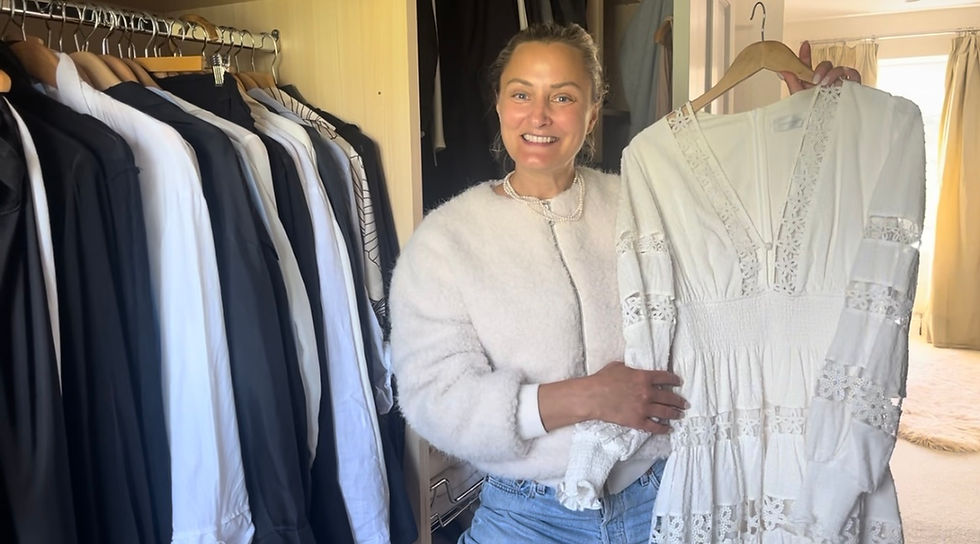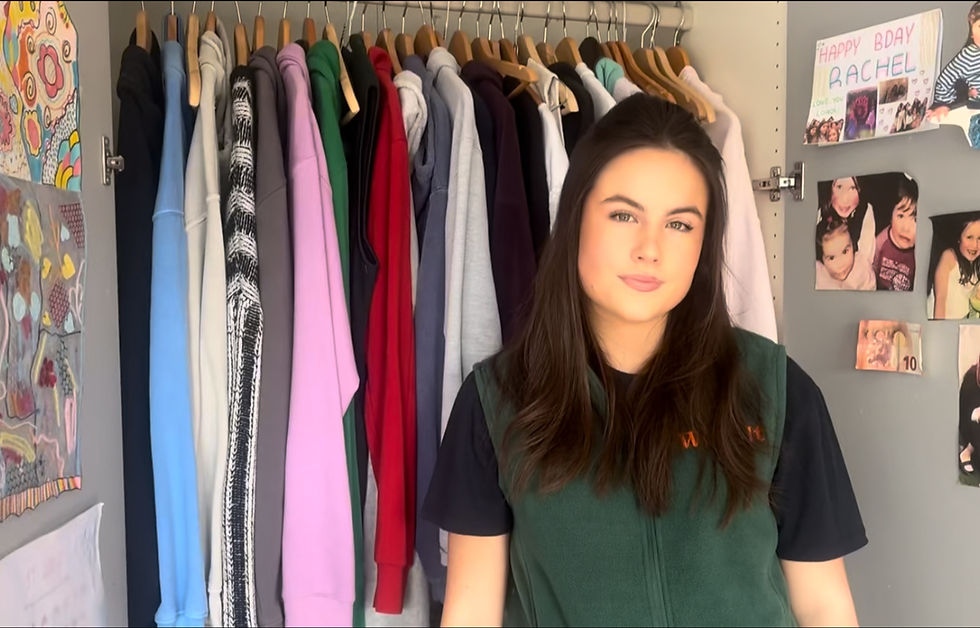It's time to reimagine fashion: How to consume less without losing your style
- niamhhatfield
- May 14
- 4 min read
Updated: May 17
By Niamh Hatfield

The throwaway culture has worsened dramatically, with many clothing items now worn just seven to ten times before being discarded. This isn’t just about waste — our emotions, shopping habits, and exposure to nonstop fashion ads create a cycle of quick satisfaction from buying something new, which often leads to lasting harm to the environment.
Designer and author Patrick Grant, who owns the brand Community Clothing, explains that while it's natural to get bored with what we have, the fashion industry has built systems that are carefully designed to keep us buying more and more.
Grant highlights how impulsive purchases offer only fleeting satisfaction, noting that “if this form of shopping gives us any pleasure at all, it is momentary at best.”
Audio by Niamh Hatfield: Grant discusses the fashion industry's influence on consumer behaviour
In his book Less: Stop Buying So Much Rubbish he says the fashion industry has created an endless cycle of desire and adopted the concept of ‘Keep the consumer dissatisfied’. It means that buying more is pushed as a sign of progress, making people feel the need to replace the old with the new. This keeps us trapped in a cycle where we buy things we don’t really need, ensuring that consumption never stops.
Social media, influencers and trends
Inga Jackson, founder of the clothing brand Silk and Grey, points out how she’s constantly bombarded with clothing ads and promotions on social media. Fashion design student Rachel Carson feels the same way, saying she doesn’t want to see them but it’s tough to avoid since they’re everywhere. "It’s hard to escape the constant pressure to shop".
Social media has become a major influence on our shopping habits, particularly when it comes to clothing. With constant exposure to influencer posts, brand deals, and targeted ads, we’re regularly marketed to, often without even realising it. Scrolling through feeds has become a daily habit, bombarding us with new outfits and trends that create pressure to buy in order to stay ‘on trend’.
Why thrifting alone won’t fix fashion’s waste problem
While second-hand fashion is often promoted as a more sustainable alternative to fast fashion, it isn't always the more affordable option. In some cases, second-hand prices can exceed retail. For example, a £29.99 Zara dress is currently being sold for £56 on Depop, and more desirable items often get sold out in stores only to be sold for twice the price on reselling platforms.
Audio by Niamh Hatfield: Grant discusses the realities of modern-day second hand shopping
Many high street retailers offer clothing at such low prices that it’s often cheaper than items found on resale platforms like Depop or Vinted. To make matters worse, much of what’s being resold are fast fashion items, which feels pointless when you could buy them new for less at the store. If buying second-hand can cost nearly double the retail price, what incentive remains for consumers to choose the more sustainable option?
Liz Ricketts, co-founder and director of the Or Foundation which champions a justice-led circular fashion economy emphasised that cutting the overall supply of clothing is essential. “I don't see a world where second-hand, upcycled, and recycled products can compete unless we reduce the production of new clothes,” she said.
Audio by Niamh Hatfield: Grant discusses the impact of social media on the fashion industry.
Industry responsibility
Brands have a major role in tackling overconsumption, but overproduction continues to flood the market with cheap, disposable fashion. Reducing output could cut waste, slow shopping habits, and support more sustainable alternatives. Yet with only 12% of brands disclosing how much they produce, according to Fashion Transparency Index 2023, holding them accountable remains a challenge.
While we can’t always control what brands do, we can make more informed choices about where we spend our money. As consumers, this is where we can take control. Grant suggests “building relationships with brands we trust—learning their values, understanding how and why they produce, and choosing those that prioritise quality over price”.
“We need to demand better, make informed purchase decisions not impulse buys, and buy what we need, resisting the lure of offers and discounts.”
No spend year
Carson says she was inspired by journalist Michelle McGagh’s book The No Spend Year: How You Can Spend Less and Live More. She realised she was buying more clothes than she actually wore, so she set herself a challenge to go an entire year without buying any new clothes.
A few months in, Carson started to rediscover clothes she already owned, and things she hadn’t worn in ages suddenly felt new again. She says the key to sticking with it, especially when tempted to shop, is borrowing items from friends or family, or using clothing rental services for special occasions.

For example, renting a dress from the brand Nobody’s Child costs just £6 per day, with a minimum four-day rental coming to £24. In contrast, buying a similar dress from the brand usually costs around £130. For people who need an outfit for a special occasion but don’t want to spend a lot on something they’ll only wear once, renting offers a smart and sustainable solution.
Carson’s experience shows that even a short break from shopping can shift how we think about consumption. It helps us value what we already own and rethink our habits. Change doesn’t have to be all or nothing—just paying attention to what we buy and wear can lead to small, realistic steps like swapping with friends, buying second-hand, or choosing fewer, longer-lasting pieces. It’s about thoughtful choices, not strict rules.
As Grant says in his book, ‘we need to buy fewer things, own a lot less stuff, use less of everything, and wean ourselves off our manic consumption. G.K. Chesterton said ‘there are two ways to get enough. One is to continue to accumulate more and more. The other is to desire less’. Less is easy. Everyone can afford last, everyone has room in their life for less. Everyone has time for less.’



Comments